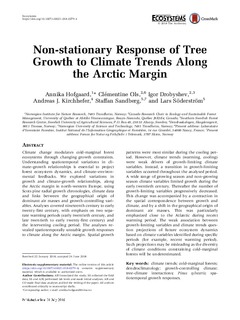| dc.contributor.author | Hofgaard, Annika | |
| dc.contributor.author | Ols, Clementine | |
| dc.contributor.author | Drobyshev, Igor | |
| dc.contributor.author | Kirchhefer, Andreas J. | |
| dc.contributor.author | Sandberg, Staffan | |
| dc.contributor.author | Söderström, Lars | |
| dc.coverage.spatial | arctic, north-western Europe | nb_NO |
| dc.date.accessioned | 2018-08-27T08:50:55Z | |
| dc.date.available | 2018-08-27T08:50:55Z | |
| dc.date.created | 2018-08-22T23:21:02Z | |
| dc.date.issued | 2018 | |
| dc.identifier.issn | 1432-9840 | |
| dc.identifier.uri | http://hdl.handle.net/11250/2559396 | |
| dc.description.abstract | Climate change modulates cold-marginal forest ecosystems through changing growth constraints. Understanding spatiotemporal variations in climate– growth relationships is essential to project forest ecosystem dynamics, and climate–environmental feedbacks. We explored variations in growth and climate–growth relationships, along the Arctic margin in north-western Europe, using Scots pine radial growth chronologies, climate data and links between the geographical origin of dominant air masses and growth-controlling variables. Analyses covered nineteenth century to early twenty-first century, with emphasis on two separate warming periods (early twentieth century, and late twentieth to early twenty-first century) and the intervening cooling period. The analyses revealed spatiotemporally unstable growth responses to climate along the Arctic margin. Spatial growth patterns were most similar during the cooling period. However, climate trends (warming, cooling) were weak drivers of growth-limiting climate variables. Instead, a transition in growth-limiting variables occurred throughout the analysed period. A wide range of growing season and non-growing season climate variables limited growth during the early twentieth century. Thereafter the number of growth-limiting variables progressively decreased. This change was accompanied by a contraction in the spatial correspondence between growth and climate, and by a shift in the geographical origin of dominant air masses. This was particularly emphasized close to the Atlantic during recent warming period. The weak association between growth-limiting variables and climate trends question projections of future ecosystem dynamics based on climate variables identified during specific periods (for example, recent warming period). Such projections may be misleading as the diversity of climate conditions constraining cold-marginal forests will be underestimated. climate trends; cold-marginal forests; dendroclimatology; growth-controlling climate; tree-climate interactions; Pinus sylvestris; spatiotemporal growth responses. | nb_NO |
| dc.language.iso | eng | nb_NO |
| dc.rights | Navngivelse 4.0 Internasjonal | * |
| dc.rights.uri | http://creativecommons.org/licenses/by/4.0/deed.no | * |
| dc.subject | climate trends | nb_NO |
| dc.subject | cold-marginal forests | nb_NO |
| dc.subject | dendroclimatology | nb_NO |
| dc.subject | growth-controlling climate | nb_NO |
| dc.subject | tree-climate interactions | nb_NO |
| dc.subject | Pinus sylvestris | nb_NO |
| dc.subject | spatiotemporal growth responses | nb_NO |
| dc.title | Non-stationary Response of Tree Growth to Climate Trends Along the Arctic Margin | nb_NO |
| dc.title.alternative | Non-stationary Response of Tree Growth to Climate Trends Along the Arctic Margin | nb_NO |
| dc.type | Journal article | nb_NO |
| dc.type | Peer reviewed | nb_NO |
| dc.description.version | publishedVersion | nb_NO |
| dc.rights.holder | 2018 The Author(s) | nb_NO |
| dc.subject.nsi | VDP::Zoologiske og botaniske fag: 480 | nb_NO |
| dc.subject.nsi | VDP::Zoology and botany: 480 | nb_NO |
| dc.source.journal | Ecosystems | nb_NO |
| dc.identifier.doi | 10.1007/s10021-018-0279-4 | |
| dc.identifier.cristin | 1603898 | |
| dc.relation.project | Norges forskningsråd: 176065 | nb_NO |
| dc.relation.project | Norges forskningsråd: 160022 | nb_NO |
| dc.relation.project | Norges forskningsråd: 244557 | nb_NO |
| dc.relation.project | Nordisk Råd: 12262 | nb_NO |
| cristin.unitcode | 7511,2,0,0 | |
| cristin.unitname | Avdeling for terrestrisk økologi | |
| cristin.ispublished | true | |
| cristin.fulltext | original | |
| cristin.qualitycode | 2 | |

